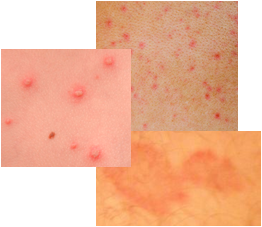Actinic Keratosis
Visit this
PICTURES OF RASHES PAGE
Actinic keratosis is sometimes referred to as solar keratosis, sun spots, actinic keratoses, or AKs.
Symptoms
It is a growth that appears on the surface or slightly beneath the surface of the skin. The growth or horn may be crusty or scaly and generally has a rough texture and may be flat. The color of the growth can vary and may be the skin tone of the individual or red, tan, or pink in light or dark shades. White scale can be present on the top. It is common for the actinic keratosis growths to be a mixture of these colors as well. The size can range from the head of a pin to an inch or 25 mm in diameter. On average, the size of solar keratosis spots is between 2 mm and 6 mm.
The actinic keratosis may itch or produce a prickly sensation. It generally takes many years to develop, but can appear much earlier in people that have received a lot of sun exposure before the age of 18.
Where Does it Appear?
Solar keratosis growths usually appear on areas of the skin that are frequently exposed to sunlight. These areas include the face, ears, lips, scalp, neck (especially the back of the neck), back of the hands, forearms, and the upper chest and upper back or shoulder regions. Fair skinned individuals (blonds, redheads) are more susceptible to this skin problem. In addition, people that are immunosuppressed because of medication or illness are also placed in a higher risk group for developing actinic keratoses.
A Precancerous Condition
This type of keratosis is a precancerous condition. In others words, there is the potential that these sun spots will turn into squamous cell carcinoma in up to 15 percent of the cases and therefore, a close watch should be kept on these growths. A visit to a dermatologist is recommended for a more thorough examination of the skin problem.
Actinic Keratosis Treatment Options
These growths do not always need to be removed. In fact, some may actually disappear on their own. A dermatologist would make the decision for treatment. If it is decided to remove the keratosis, then this can be achieved by a variety of ways.
- The use of liquid nitrogen or cryosurgery is frequently used to freeze the growths off the skin.
- The keratosis spot may also be burned, scraped or shaved off the skin.
- Another option is the use of chemical peels which act to remove the top layers of skin and thus also remove the actinic keratoses.
- Various medicated creams such as Aldara or Efudex and Carac with contain the active ingredient 5-fluorouracil can be used for treatment.
- A photo therapy procedure that involves injecting a chemical into the bloodstream. This chemical accumulates in the actinic keratosis growth and makes it susceptible to breakdown by the effluence of specialized light.
More information on different types of keratosis:
keratosis | follicular | pilaris | seborrheic | senile | actinic cheilitis
